Quality of the Environment in Japan 1996
Part II
Fig. 5-1-8 Attainment of Environmental Quality Standards for Suspended Particulate Matters
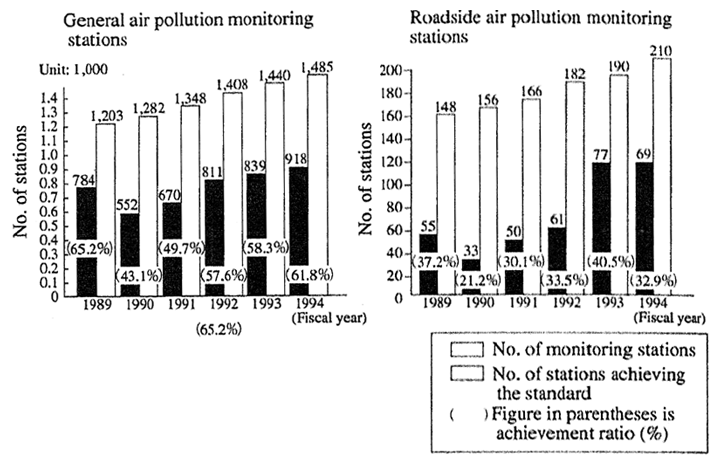
Note: Roadside air pollution monitoring station where the sampling inlet is over the road is excluded.
Source: Environment Agency
Fig. 5-1-9 Trend of Annual Average Value for Suspended Particulate Matters
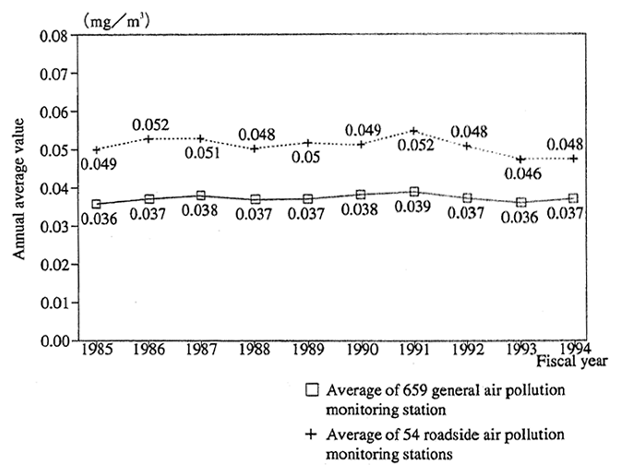
Source:Environment Agency
Meanwhile,concerning particulate matter contained in motor ve-hicle exhaust emission gases,in line with the short-term target set forth in the Central Council for Environmental Pollution Control Report of December 1989,regulation of diesel smoke that is subject to regulation has been strengthened and new regulations with respect to all particu-late matter have been implemented since 1993 and 1994. Further,also concerning the long-term target of reducing the amount of particulate matter emission from diesel-fueled vehicles by 60% or more,the pros-pect of achieving it for all vehicle types by 1999 has been secured.
B. Soot and Dust and General Particulate Countermeasures
Concerning soot and dust,emission standards are established for each type and scale of facility,further,in areas where facilities are con-centrated and pollution is conspicuous,still more severe special emis-sion standards have been established with respect to new and enlarged facilities.
As countermeasures to soot and dust generating sources,aside from proper combustion management,etc.,there is dust collecting equipment. (Figure 5-1-10)
Concerning general particulate (amongparticulatesthis is par-ticulate other thandesignated particulate(at present,asbestos is des-ignated by government ordinance); refer to 4 (2) A. Asbestos Counter-measures),standards concerning the structure,use and management of facilities that generate general particulate have been established such as places of accumulation and conveyors.
(3) Studded Tire Dust Countermeasures
Recently,automobiles equipped with studded tires in snowy and cold regions had generated a large amount of dust (hereafter called studded tire dust) by damaging the road,and because it has become a serious social problem on the living environment and people's health, the Studded Tires Regulation Law was promulgated and enforced in June 1990. As of April 1996,803 cities,towns and villages of 18 prefec-tures have been designated as regions where the use of studded tires within these regions is prohibited by the Director-General of the Envi-ronment Agency.
Further,as this law requires the national and local governments to promote and implement related measures for the prevention of the generation of studded tire dust,the Environment Agency made pam-phlets for safety driving on frozen road surfaces and maps of designated regions,and distributed them to the prefectures concerned,and so on.
Fig. 5-1-10 State of Installation of Dust Collector
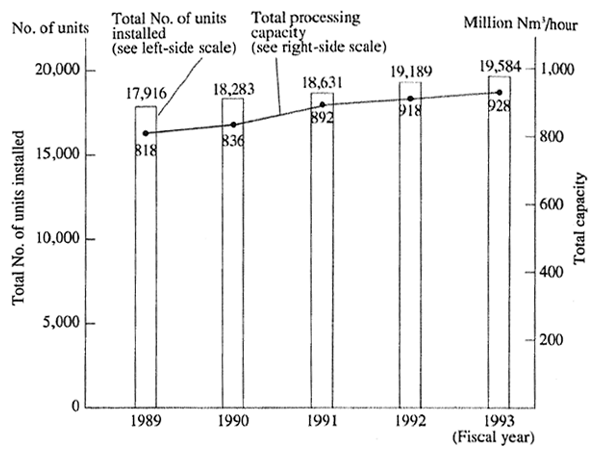
Source: Environment Agency
(4) Sulfur Oxide Countermeasures,etc.
A. The Present State of Air Pollution Due to Sulfur Oxides,etc.
(A) The Changes in the Annual Average Value of Sulfur Dioxide
The number of valid monitoring stations concerning sulfur diox-ide in FY 1994 was 1,604 general stations in 697 cities,towns and vil-lages and 92 roadside stations in 73 cities,towns and villages.
The changes in the annual average value at continuous monitor-ing stations (1,356 general stations,42 roadside stations) in the past 10 years are given in Figure 5-1-11,and in FY 1994 it was 0.005 ppm at gen-eral stations,unchanged from FY 1993,and at roadside stations it was 0.008 ppm,higher compared to FY 1993.
Fig. 5-1-11 Trend of Annual Average Values for Sulfur Dioxide
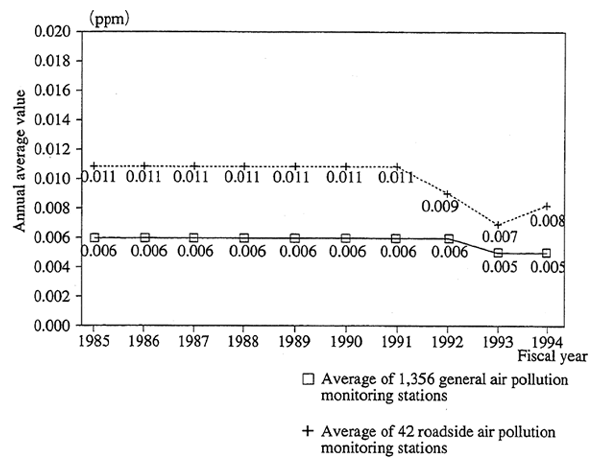
Source: Environment Agency
(B) Condition That Conforms to the Environmental Quality Standard Concerning Sulfur Doxide Based on Long-term Evaluation
In the long-term evaluation of the environmental quality stan-dard,when the value excluding those in the range of 2% from the upper measurement value among the one day average values in a year does not exceed 0.04 ppm,and there are not two or more days in succession through a year on which the one day average value exceeds 0.04 ppm,it is regarded as conforming to the environmental quality standard.
The changes in the condition of achieving the environmental standard based on the long-term evaluation is as in Table 5-1-9 and,re-cently,a high achievement level has been maintained.
Table 5-1-9 State of Conformity to Environmental Quality Standards for Sulfur Dioxide (Long-term Evaluation)
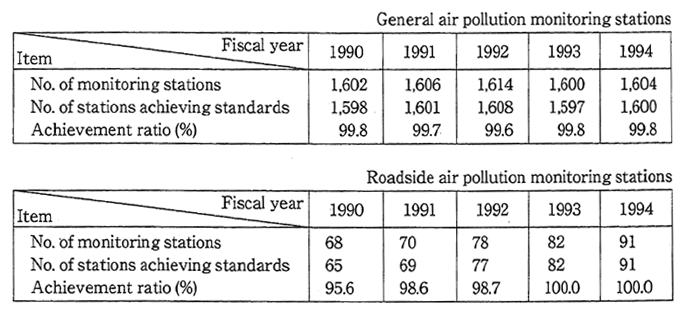
Notes:1.Excludes monitoring stations that did not achieve standards within a valid
monitoring period.
2. Roadside air pollution monitoring station where the sampling inlet is over the
road is excluded.
Source: Environment Agency
(C) Conditions That Conform to the Environmental Quality Standard Concerning Sulfur Dioxide Based on Short-term Evaluation
In the short-term evaluation,when the one day average value at all the valid monitoring stations (meaning days on which measurement is carried out 20 hours or more a day,hereafter it is the same) is 0.04 ppm or less,or the one hour value in all the measurement hours is 0.1 ppm or less,it is regarded as conforming to the environmental quality standard.
The percentage,with respect to the number of valid monitoring stations,of the number of monitoring stations where the one day aver-age value on all of the valid measurement days was 0.04 ppm or less,in FY 1994 maintained the same high level as in FY 1993 of 99.3% for gen-eral stations and 100% for roadside stations. Further,also concerning the percentage with respect to valid monitoring stations of the number of stations at which the one hour value in all of the measurement hours was 0.1ppm or less,in FY 1994 the same high level was maintained as in FY 1993 with 96.3% for general stations and 98.9% for roadside sta-tions.
(D) Changes of the Annual Average Value of Carbon Monoxide
The number of valid monitoring stations concerning carbon mon-oxide in FY 1994 was 184 monitoring stations in 155 cities, towns and villages for general stations, and 345 roadside stations in 206 cities, towns and villages.
The changes in the annual average value in continuous monitor-ing stations (150 general stations, 233 roadside stations) in the past 10 years is as in Figure 5-1-12, and in FY 1994 it was 0.6ppm at general sta-tions, unchanged from FY 1993, and 1.2ppm at roadside stations, lower when compared to FY 1993.
Figs 5-1-12 Trend of Annual Average Values for Carbon Monoxide
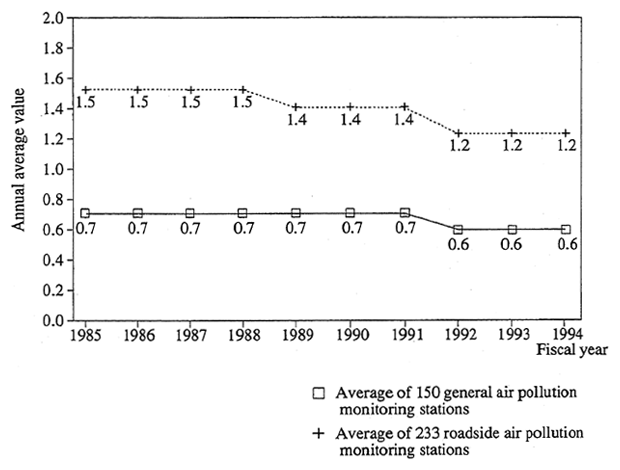
Source:Environment Agency
(E) Conditions Conforming to the Environmental Quality Standard Concerning Carbon Monoxide
In the long-term evaluation of the environmental quality stan-dard,when among the one day average values in a year the value ex-cluding those within the rang of 2% from th upper measurement value does not exceed 10%,and there are not two or more days in suc-cession,through a year,on which the one day average value exceeds 10 ppm,it is regarded as conforming to the environmental quality stan-dard. Meanwhile,in the short-term evaluation,when the one day aver-age value of the one hour value is 10ppm or less,and th eight hour av-erage value of the one hour value is 20ppm or less,it is regarded as con-forming to the environmental quality standard. In F Y 1994,continuing from FY 1993,in all the monitoring stations of both th general stations and the roadside stations,the environmental quality standard was achieved by means of both evaluations.
B. Countermeasures
In regards to sulfur oxide emission regulation,regulations are im-plemented according to an emission standard per facility and the total mass emission control standard per factory in high pollution regions. Regulation according to the emission amount per facility is called K-value regulation. The allowable limit of the amount of sulfur oxide emis-sion corresponds to the value of the constant K which is determined for each region (16 ranks between 3.0 and 17.5. It is more scvere as the value of K becomes smaller) and the height of the emission Opening. The value of K has been revised and strengthened,in phases,eight times since December 1968. The factory unit total mass emission control is im-plemented in total mass emission control regions designated by the na-tion (regions where factories and places of business are concentrated and it is difficult to ensure the environmental standard by means of the emission standard only),based on the total mass reduction plan created by the prefectural governors. At present,it is implemented in 24 re-gions. Besides this,a fuel standard concerning the percentage of the sul-fur content of petroleum based fuel has been established with respect to regional soot and dust emitting facilities that produce conspicuous air pollution seasonally due to the increase in the amount of fuel used due to heaters,etc.,and small-scale factories and places of business to which the total mass emission control standard does not apply and are in total mass emission control regions.
The desulfurization of fuel oil and the installation of emitted smoke desulfurization equipment,etc.,have been devised as generation source countermeasures to regulate the emission of sulfur oxides.
Concerning fuel oil desulfurization,since 1967 direct desulfuriza-tion and indirect desulfurization equipment have been installed,but the fuel oil processing capacity of the end of FY 1994 was,respectively, 79,000kl/day at 14 facilities and 133,000kl/day at 26 facilities. Through this kind of fuel oil desulfurization,etc.,improvement of the quality of fuel is progressing and the average percentage of the sulfur content of the fuel oil used for domestic consumption in FY 1994 amounted to 1.09%.
Further,concerning emitted smoke desulfurization equipment, the number of facilities installed and the processing capacity have both steadily increased (Figure 5-1-13).
By means of all of these countermeasures,the state of air pollu-tion due to sulfur dioxide has conspicuously improved when compared to the first half of the decade that began in 1965.
Fig. 5-1-13 State of Installation of Smokestack Desulfurization Equipment
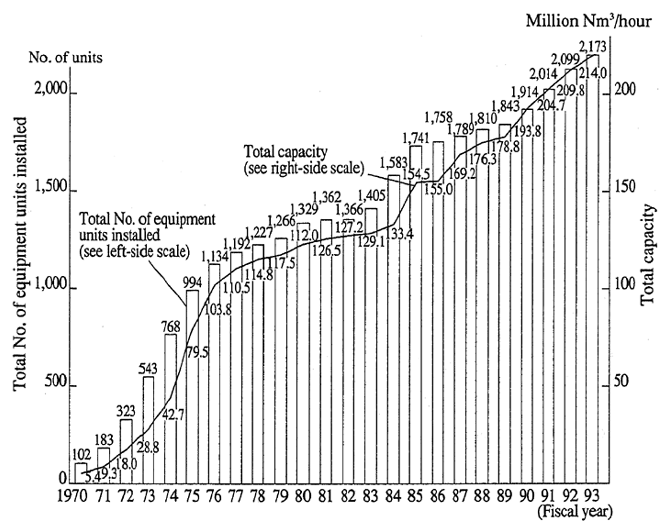
Note:Figures through fiscal year 1982 are for 1 January of each year,while figures for fiscal year 1983 and onward are for 31 March.
Source:Environment Agency
4. The Prevention of Influences on Health Due to Diverse Toxic Substances
(1) The Present State of Air Pollution Due to Diverse Toxic Substances
Recently,particles are regarded with caution by their qualitative components rather than just their quantity. At the national air pollution monitoring stations set up in the principal regions of the country,other than the substances mentioned above that are always observed and measured,analysis is being carried out of components of floating dust extracted by a high volume air sampler (benzene soluble substances, sulfuric acid base,nitric acid base,heavy metals such as vanadium, benzo (A) pyrene,etc.) and components in suspended particulate matter extracted by a low volume air sampler (31 elements such as aluminum, barium,etc.).
In addition,concerning substances for which their long-term changes are necessary to comprehend since they are diverse toxic sub-stances that have been detected in the air,a monitoring survey of un-regulated air pollutants has been implemented since FY 1985. In FY 1994,continuing from FY 1992,surveys concerning formaldehyde and dioxins have been implemented.
In the FY 1994 survey results,when compared to the results of the former survey,high levels of formaldehyde were detected near main highways,but in other areas the levels were about the same. Fur-ther,concerning dioxins,when compared to the previous time the levels were about the same. From now on also,in addition to continuing to im-plement monitoring,it is necessary to accurately comprehend the con-centration of diverse toxic substances in the air (Table 5-1-10).
(2) Countermeasures
A. Asbestos Countermeasures
Because asbestos has excellent insulating properties it was used in many products,but it has an effect on health such as causing cancer.
For this reason,by means of the revision of the Air Pollution Con-trol Law of 1988,among dust,asbestos was regarded as a designated dust and,in addition to regarding the manufacturing facilities of asbes-tos products as designated particulate discharging facilities,control has been carried out by means of notifications of the establishment of desig-nated particulate discharging facilities,orders to change plans,the duty to observe the designated particle regulation standard,improvement orders and measurement of the concentration of designated particulate. Further,at the Environment Agency,asbestos measurement technician training projects and surveys concerning the state of use of asbestos substitutes are being implemented.
Further,the scattering of asbestos accompanying the disman-tling of buildings that suffered damage in the recent Hanshin-Awaji Great Earthquake has caused concern and,based on the fact that thor-ough countermeasures are called for,and that about 30 years have al-ready elapsed since buildings using asbestos began to b built,and that an increase in dismantling for the purpose of rebuilding them can be ex-pected from now on,in order to devise the measures necessary for es-tablishing the standards related to the method of the work of disman-tling buildings that use spray asbestos,the draft of legislation to revise a part of the Air Pollution Control Law was submitted in March 1996 to the 136 th session of the Diet.
Table 5-1-10 Monitoring Results for Non-regulated Air Pollutants in FiscalYear 1994
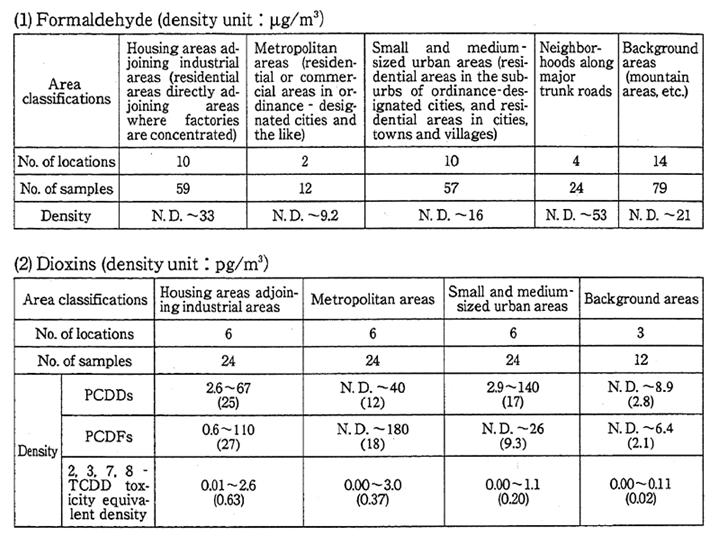
Notes 1.1μg is one-millionth of 1 gram. 1pg is one-trillionth of 1 gram.
2.N.D.means below the limit of detection.
3.The figures in parentheses are the calculated average values,with N.D. calcu-lated as being one-half the limit of detection.
4. PCDDs mean polychiorinated dibenzo-p-dioxin,and PCDFs mean polychlo-rinated dibenzofuran.
5.2,3,7,8 -TCDD toxicity equivalent densityis the total sum value of the vari-ous metamer densities of dioxins calculated in terms of 2,3,7,8 -TCDD metam-ers.
Source:Environment Agency
B. Countermeasures to Toxic Substanecs
In the Air Pollution Control Law,astoxic substancescoming from soot and smoke emitting facilities,besides nitrogen oxide,(i) cad-mium and its chemical compounds,(ii) chlorine and hydrogen chloride, (iii) fluorine,hydrogen fluoride and silicon fluoride and (iv) lead and its compounds are regulated. The emission stndards concerning the above mentioned toxic substances,are established with respect to types of soot and smoke emitting facilities limited by the type of each toxic substance,but this is because the generaition of a toxic substance is due to specific raw materials.
C. Countermeasures for Toxic Substances That Are Not Yet Regulated
From the viewpoint of preventing the occurrence of air pollution, substances are being selected one by one from among the toxic sub-stances that have not yet been regulated but for which th re is concern about their toxicity,and surveys are being carried out concerning their emission concentrations and influence on the environment,etc.
Concerning the prevention of air pollution due to trichloroethyl-ene and tetrachloroethylene,based on the report of theOrganochlo-rine Compound Countermeasures Study Committeein April 1993,the Air Environment Guideline (provisional values) (trichioroethylene 250 micrograms/m3 or less,tetrachloroethylene 230 micrograms/m3 or less at the annual average value) was decided as the guidelines that should be maintained to protect human health,further,in addition to compiling the Provisional Countermeasures Guidelines concerning Discharge of Trichloroethylene and Tetrachloroethylene into the Air,the actual situation was comprehended through prefectural governors and the mayors of government ordinance designated cities.
Further,according to the results of a recent Japanese air envi-ronment survey,various substances,the carcinogenic toxicity of which is regarded as a problem,have been detected from the air,although in low concentrations,and the situation has reached the point that there is concern about their influence on the health of the nation's citizens due to long-term exposure,depending upon the substance. For this reason, in September 1995 an examination offuture measures for hazardous air pollutantswas carried out in the Central Council for Envieonmental Pollution Control,and in January 1996 in the same council an interim re-port was compiled. In this report,from the viewpoint of preventing in-fluences on health,it was decided that in addition to hurrying the crea-tion of a system,including also a legal framework,in order to promote policies based on this report,the work of deciding upon the target sub-stances,establishing the environmental target values and realizing emission restriction countermeasures should proceed while listening widely to the opinions of each related interest. For this reason,based on this interim report,thedraft of legislation to revise in part the Air Pollution Control Law, that incorporated various stipulations concern-ing the promotion of hazardous air pollutant countermeasures,was sub-mitted to the Diet in March 1996. In this draft the following are stipu-lated (i) the duty of businesses to restrict the emission of hazardous air pollutants; (ii) comprehending the state of air pollution due to hazard-ous air pollutants,evaluating and announcing the extent of the danger of harm to health,giving information to businesses and diffusing knowl-edge to citizens by local government bodies; (iii) concerning substances for which immediate emission restrictions should be devised,such as benzene,for the time being,indicating the emission restriction standard and calling upon businesses for still more accurate emission restriction measures; and (iv) concerning the above measures,in order to compre-hensively take into consideration the extent of the perfection of scien-tific knowledge from now on and the results of the measures by busi-nesses,and to provide for still more enhanced countermeasures from the viewpoint of preventing harm to health,in addition to studies with a target of three years after the draft of this law comes into effect,devis-ing the necessary measures,including reviewing the system,etc.,based on the results of this.
5. Countermeasures to Regional Living Environment Problems
(1) Noise and Vibration Countermeasures
A. Introduction
(A) The Present State of Noise and Vibration
Even among the various kinds of pollution,noise is a problem closely associated with our daily life,and because its sources are many and diverse,in the average year,among the complaints related to pollu-tion,there are more complaints due to noise than anything else.
As for the sources of noise for which the complaints are made, the number of complaints made for noise caused by factories and work-shops accounts for most,noise caused by construction works came sec-ond,followed by business noise and noise from homes (Figure 5-1-14).
The number of noise complaints has been in a declining trend for the past few years,but in FY 1994 they increased compared to the pre-vious year. Among them,noise generated in homes k increasing slightly.
Meanwhile,vibration,among the various types of pollution, is a problem with a deep relationship to daily life along with noise. When the changes in the numbers of complaints are looked at,there has been a declining trend for the last few years,but in FY 1994 the number in-creased compared to the previous year at 2,547 cases.
Fig. 5-1-14 Trend in Number of Complaints about Noise
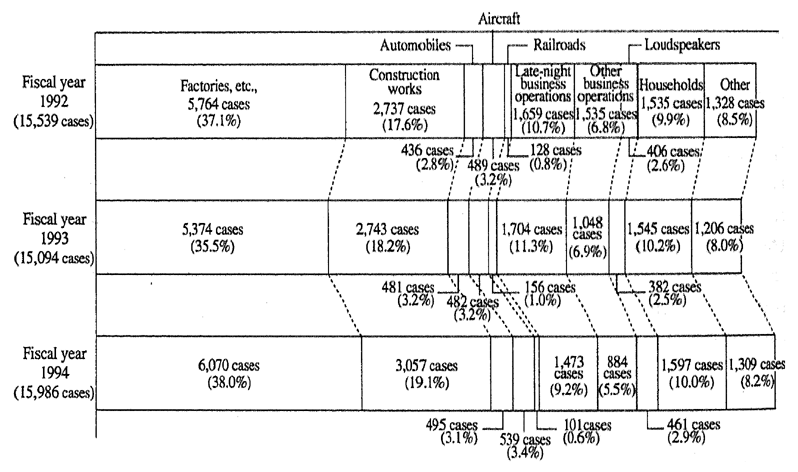
Source: Environment Agency
When the breakdown of this is looked at,most complaints were due to construction works vibration,vibration caused by factories and workshops came second,accounting for a large percentage,as before,as sources of complaints (Figure 5-1-15).
Fig. 5-1-15 Trend in Number of Complaints about Vibrations
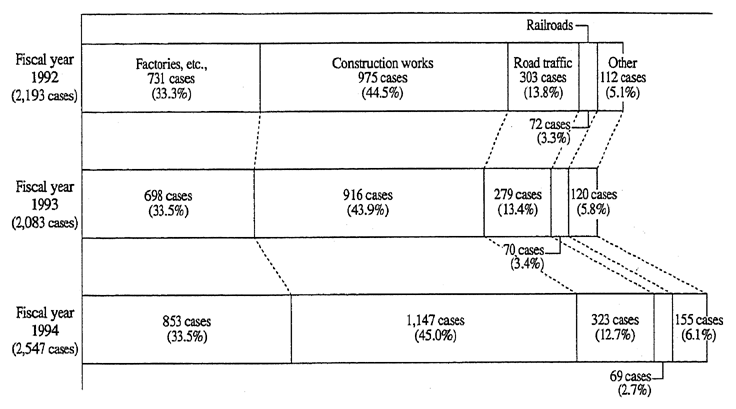
Source: Environment Agency
(B) Environmental Quality Standards for Noise
Environmental Quality Standards for Noisehave been decided based on article 16 of the Basic Environmental Law.In this standard system,areas are largely classified into two groups,general areas and areas facing roads. The standards are set for each group by type of area and by classification of time.
For the general areas,the standards are set in the range of35 dB or less,for theareas where quietness is especially requireddur-ing the night,and60dB or less,for the areas withconsiderable number of residences but also used for commercial and industrial pur-poses during the day,depending on the type of areas and classifica-tion of time. For the areas facing roads,the standards that are 5-10 dB higher than those set for the general areas have been set for each classi-fication of areas depending on the number of lanes of the roads on which the areas are facing. The classification of areas is to be made by the governor of each prefecture. As of the end of FY 1994,the classifica-tion of areas has been completed for 605 cities,883 towns,102 villages and 23 special wards in 47 prefectures.
(C) Controls under the Noise Regulation Law
TheNoise Regulation Lawspecifies that the governors of pre-fectures or metropolises (or mayors of administrative ordinance-designated cities) are to designate areas where the living environment should be preserved by controlling noise,and to control the noise which is affecting a considerably broad area,and that is caused by operations of factories and workshops,or construction works within the designated areas. The law also specifies that the Director-General of the Environ-ment Agency is to set the allowable limit of the noise level caused by automobiles,and that the governors of prefectures can demand meas-ures for noise caused by road traffic to the Prefectural Public Safety Commissions.
As of the end of FY 1994,the designation of areas by the gover-nors of prefectures or metropolises (or mayors of administrative ordinance-designated cities) has been completed for 661 cities,1,238 towns,175 villages,and 23 special wards in 47 prefectures and metropo-lises,which account for approximately 64.4% of the number of all cities, towns,wards,and villages.
(D) Controls under the Vibration Regulation Law
TheVibration Regulation Lawspecifies that the governors of prefectures or metropolises (or mayors of administrative ordinance-designated cities) are to designate areas where the living environment should be preserved by controlling vibration,and to regulate vibration which is affecting a considerably broad area,and that is caused by op-erations of factories and workshops,or construction works within the designated areas. The law also specifies that the governors of prefec-tures are to demand measures for vibration caused by road traffic from the Prefectural Public Safety Commissions.
As of the end of FY 1994,the designation of areas by the governors of prefectures or metropolises (or mayors of administrative ordinance-designated cities) has been completed for 651 cities,868 towns,98 vil-lages,and 23 speciaI wards in 47 preectures. which account for approxi-mately 50.4% of the number of all cites,towns,wards and vilIages.
B. Countermeasures to Noise and Vibration Due to Factories Or Workshops and Construction Works
(A) The Present State of Countermeasures to Noise and Vibration due to Factories or Workshops and Constrution Works
Concerning noise,Factories and workshops that have installed specially designated Faciities specified in government ordinance,such as metal Processing machinery,etc. Within the designated areas of the Noise Regulation Law(called thespecified factories,etc." hereafter) be-come subject to regulation and the total number of specified factories, etc. in the designated areas as of FY 1994 was 204,838.
Specified construction works,such as piling works,etc.,specified in government ordinance carried out within the designated areas,will be subject to regulation. The number of reports of the execution of specified construction works in FY 1994 was 38,5
Concerning vibration,regulations are applied to the factories and workshops which are located within the designated area of the Vibra-tion Regulation Law and are epuipped with ficilities specified in the government ordinance,such as metal processing machinery,etc.(called thespecified factories,etc.hereafter). The number of specified facto-ries,etc. within the designated areas is 117,730 as of the end of FY 1994.
Regulations are applied to construction works that are pre-formed within th designated areas and that are specified in govern-ment ordinance,such as piling wonks,etc. There were 25,577 cases of notification concerning the execution of specificed construction works in FY 1994.
(B) Countrmeasures
a. Factories and Workshops
Concerning noise,the specified factories,etc. within the desig-nated areas are bound to conform to the regulation standards. The gov-ernors of prefectures or metropolises (or mayors or superintendents of cities,towns or villages-applicable hereafter) can give the specified fac-tories,etc. recommendation to change plans or recommendation to make improvements,when it is recognized thatit the living environment of the surrounding areas is being marred by the noise which is gener-ated from their facilities,and which is not satisfying the regulation stan-dards. There were three cases where recommendation to make im-provements was given in FY 1994. Besides these measures per the Noise Regulation Law,1,038 cases of administrative guidance concern-ing noise controls,such as collecting of reports based on complaints, were carried out.
With the rapid progress of urbanization in the suburbs of large cities,new residential areas are forming around factories that have been in operation for many years. Recently,the number of noise problems in the suburban areas is increasing in this way. An investigation to study measures for this type of noise problem was conducted. Another inves-tigation was conducted to study the possible application of regulations to non-restricted facilities.
Meanwhile,concerning vibration,the specified factories,etc., within the designated areas are bound to conform to the regulation standards. The governors of prefectures or metropolises (or mayors or superintendents of cities,towns,or villages-applicable hereafter) can give the specified factories,etc.,recommendation to change plans or recommendation to make improvements,or issue orders to make im-provements,when it is recognized that the living environment of the surrounding areas is being marred by the vibration which is generated from their facilities,and which is not satisfying the regulation standards. There was one case where recommendation to make improvements was given in FY 1994. Besides these measures per the Vibration Regulation Law,176 cases of administrative guidance concerning controls of vibra-tion,such as collecting of reports based on complaints,were carried out.
In the areas where residences and factories are intermixed and noise and vibration pollution already exists,measures such as installa-tion of noise barriers and vibration control equipment,relocation of fac-tories and workshops out of areas,etc. are effective to control pollution. However,most of the factories and workshops contributing to pollution are small-scale operations and usually are not able to relocate easily due to financial reasons. To help resolve this problem,the Small and Me-dium Enterprises Finance Corporation provides loans for relocation costs,and the Japan Environmental Corporation carries out construc-tion of structures built collectively.
b. Construction Works
The governors of prefectures or metropolises can give the per-son in charge of the construction recommendation to make improve-merits, or orders to make improvements concerning methods of noise control, when it is recognized that the living environment of the sur-rounding areas is being marred by the noise which is generated by the construction works, and which is not satisfying the regulation standards. No recommendation or orders to make improvements were issued in FY 1994.540 cases of administrative guidance concerning noise controls, such as collecting of reports based on complaints, were carried out.
The governors of prefectures or metropolises can give the per-son in charge of the construction recommendation to make improve-ments, or orders to make improvements concerning methods of vibra-tion control, when it is recognized that the living environment of the surrounding areas is being marred by the vibration which is generated by the construction works, and which is not satisfying the regulation standards. No recommendation or orders to make improvements were issued in FY 1994. 274 cases of administrative guidance concerning vi-bration controls, such as collecting of reports based on complaints, were carried out.
To control noise and vibration caused by construction works, de-velopment and advancing of low-noise and low-vibration construction equipment and methods have been carried out.
C. Automobile Traffic Noise and Vibration Countermeasures
(A) State of Automobile Traffic Noise
Concerning automobile noise, the results of the measurements of 4,801 monitoring stations (limited to those measured in specially desig-nated regions based on theNoise Regulation Law) that prefectures, cities, towns, villages and special districts carried out in FY 1994 at those points which are considered to have the noise level that is repre-sentative of given areas or those points where roadside noise level may cause problems are shown in Figure 5-1-16. Nationwide, 4,152 points were not attained for the environmental quality standard, and 1,495 ex ceeded the request limit (the limit of theNoise Regulation Law Arti-cle 17 paragraph 1).
Since the measurement time is not fixed on each point,it is hard to compare the results simply. But the trend of attainment at 1,737 points which have been continuously monitored since 1990 is shown in Figure 5-1-17. There were 1,505 sites in 1994 which did not attain envi ronmental quality standard, and the results are still severe.
Fig. 5-1-16 Achievement of Enviromental Quality standards for Automobile Traffic Noise and State of Exceeding the Reguested Limits

Source:Environment Agency
Fig. 5-1-17 Trend of Attainment State of Environmental Quality Standards for Automobile Traffic Noise at Continuous Monitoring Locations (1,737 locations where measurements were made continuously for a 5-year period beginning in 1989)

Source:Environment Agency
Further,comparing the state of attainment of the environmental quality standard on large urban areas (Tokyo's 23 wards and 12 ordinance-designated cities) with regions other than these,the percent-age of monitoring stations at which the environmental quality standard was not attained was 70.4% in the large urban regions which is rather high compared to the 50.4% in other regions (Figure 5-1-18). And by classification of road,the percentage of monitoring stations at which the environmental quality standard was not attained in all of the four hour zones was high on urban highways,ordinary national highways and main regional roads in descending order (Figure 5-1-19).
Fig. 5-1-18 Attainment State of Environmental Quality Standards for Automobile Traffic Noise in Metropolitan Areas and in Other Areas

Source: Environment Agency
Fig. 5-1-19 Attainment State of Environmental Quality Standards for Automobile Traffic Noise by Type of Roadway
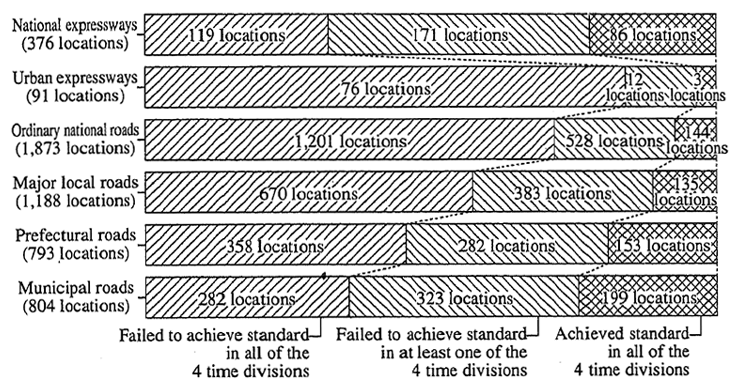
Source: Environment Agency
(B) Countermeasures
The noise from the automobile itself comes from the engine,the intake and exhaust system,the drive system and the tires. However, along the road,various factors such as the amount of traffic,the types of vehicles,the speed,the structure of the road and the roadside land use are complexly intertwined with the sound coming from the automobile itself and produce the same problem as automobile noise. In regards to the vibration in the vicinity of a road also,factors such as the automobile weight,the driving conditions and the flatness of the road,the structure of the pavement,the road structure such as the roadbed conditions,etc., are also interdependet and become the road traffic vibration probIem. In order to settIe settIe these noise and vibration probIems radicaIIy.in addi-tion to the reduction of noise by imiprovement of the structure automobile,various policies are beingb comprehensiveIy promoted such as countermeasures to their generation such as improving the driving situation,traffic flow countermeasures,road structure improvements and roadside countermeasures(Figure5-1-20).
Further,there were 16 opinion statements made with respect to road managers related to automobiIe noise int1994 (Tabie 5-1-11). the demands with respect to traffic vibration,in the Iast few years, were one each in FY 1991 and FY 1993.
Table 5-1-11 State of Demands and Opinions Offered Concerning Automobile Traffic Noise Based on the Noise ReguIation Law

Source: Environment Agency
a. Improvement of th Structure of th Automobile
Noise Regulations for the Automobile are being implemented as a generating source countermeasure to reduce th noise level coming from each automobile.
Regarding noise a regulations,a reglation is being implemented concerning three types of sound,the accelration running noise that is the largest noise generated when driving through town areas,the steady running noise that is the noise when drivig at a constant speed and the proximity stationary noise suited to the control of cars in the process of being used on the streets.
With respect to new cars,since 1971 wheh the regulation of ac-celeration running noise was implewentet,tighthening of the regIation has been carried out several times. As for regulations since 1979,they were carried out following the set target values of th permissibie limits to acceleration running noise set forth by the report of the CentraI Council for Environmental Pollution Control in June 1976,and the Iatest strict regulations are a result of great tightening,6-11 decibels when compared to the 1971 regulations.
Fig. 5-1-20 System for Road Traffic Noise Countermeasures
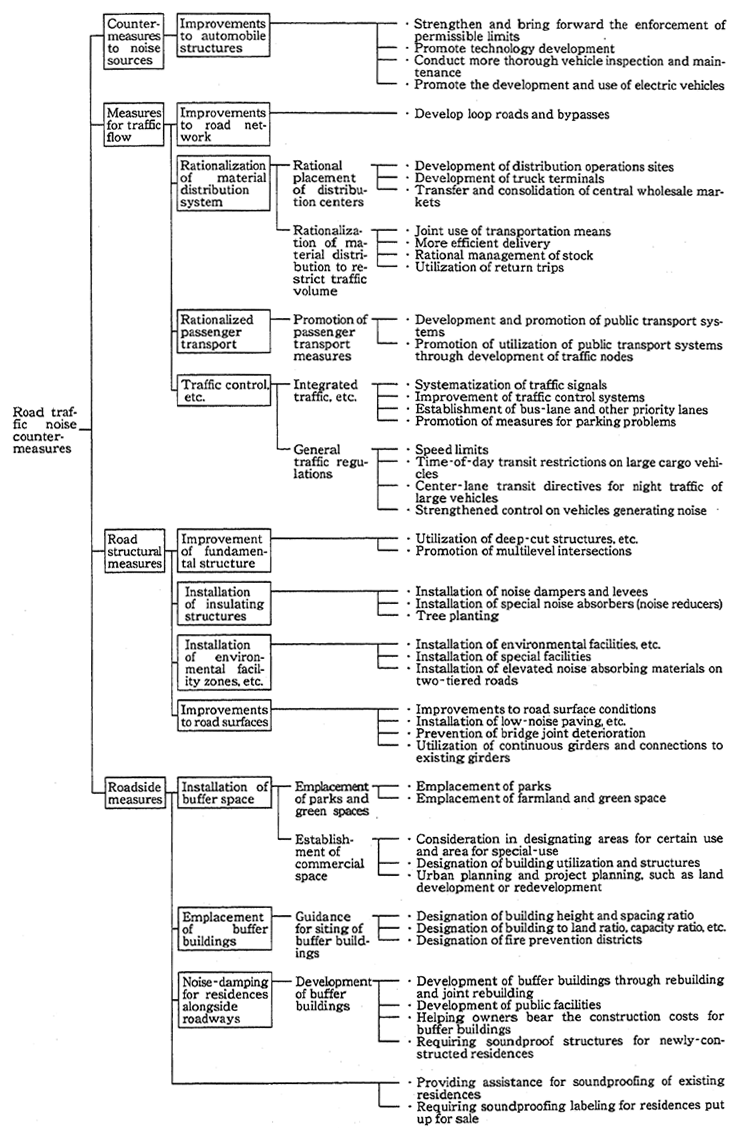
Further,the regulation of proximity stationary noise that is easy to measure on the street. has been implemented since June 1986 for not only new cars but those currently in use,and is having an effect with re-spect to the control of illegally modified vehicles. These measures are coming to play an important role in noise prevention. Particularly,since the frequent late night noisy driving by hot rodders in residential areas has become a big social problem,stronger enforcement on the failure to have a muffler,proximity stationary noise and idling is taking place. In 1995,there were 10,434 reprimands given to hot rodders for failing to have a muffler.
However,regardless of the tighthening of the regulations up to now,due to the increase in automobile traffic,the rate of attainment of the environmental quality standards had been low,especially along main highways. Because still more noise reduction was required,the Central Council for Environmental Pollution Control questioned The Future Policy for Motor Vehicle Noise Reduction in June 1991. In No-vember 1992,an interim report that centered on establishing a target value of reducing acceleration running noise by 1-3 decibels was issued. Further,in February 1995 a report was issued centering on establishing a target value to reduce steady running noise by 1-6.1 decibels and proximity stationary noise by 3-11 decibels. The target values incorpo-rated into these reports are the strictest when compared to those in the rest of the world,and the Environment Agency,following this report,is planning to achieve the target values in a short period.
b. Comprehensive Countermeasures
Guidance and assistance is being implemented for the measures of plans decided by local government bodies aiming to promote various countermeasures,such as road construction countermeasures,traffic flow countermeasures and roadside countermeasures,corresponding to the situation of the region,in line with the policies set forth in the Cen-tral Council for Environmental Pollution Control Report of March 1995 as a promotion of comprehensive road traffic noise countermeasures.
Further,the related ministries and agencies are taking seriously the Supreme Court decision (7 July 1995) of the National Highway 43, Hanshin Highway Noise and Exhaust Gas Regulations Claims Case that recognized the responsibility of the government concerning the road noise,etc.,of the national highway number 43 Hanshin expressway Kobe route,and the Liaison Conference of Ministries and Agencies re-lated to Road Traffic Pollution Countermeasures(composed of the Na-tional Police Agency the Environmnt Agency,the Ministry of Interna-tional Trade and Industry,the Ministry of Transport and the Construc-tion Ministry)was intensively held and,the policy of the related minis-tries and agencies,Concerning road traffic noise countermeasures con-cerning national highway number 43 and the Kobe route of the Hanshin Expresswaywas compiled on 30 August 1995 and set forth the frame-work for the countermeasures in this region.
Further,even when considered nationally,there are many moni-toring spots that do not achieve the road traffic noise environmental quality standard. The serious situation is Continuing in many monitor-ing spots,particularly,along the sides of th main highways in urban ar-eas,of road traffic noise that exceeds even the limits called for in the Noise Regulation Law. And there are areas in which early implementa-tion of countermeasures such as those for the are a along national high-way 43 is called for when considering the surrounding land use and traf-fic characteristics. For this reason,the related d ministries and agencies in the above mentioned liaison conference on 1 December 1995 com-piled the Policy to implement countermeasures in regions where road traffic noise seriousand,under the joint signatures of the depart-ment heads of the related ministries and ageneies,have notified all the prefecturcs in nation that each body that implements policy should cooperate in carrying out measures corresponding to their regions at th regional level.
The related ministries and agencies also are working together to earnestly promote road traffic noise countermeaures.
c. Improvement of Road Constrtruction
As countermeaures from the point of view of road construction, the provision of an environmental facility zone and a sound break wall and incrsing roadside greenery arc being promoted. Furthr,in addi-tion to the experimentaI introduction of sound absorbing panels on the back surf of elevated road and low noise pavement,technological development is being carrid out in order to provide for an improve-ment in th durability of ti noise reduction effct of low noise pave-ment.
d. Making Physical Distribution Efficient
In the area of main line physical distribution,measures to hasten the use of appropriate transportation facilities through the aggressive use of rail and ship transport in transportation between physical distri-bution bases in the medium to long distances are being promoted. Fur-ther,in the area of physical distribution within a region,the preparation of joint transportation and intraregional joint collection and delivery systems are being promoted.
Further,the preparation of access roads to harbors and airports that are important physical distribution bases,the aggressive promo-tion of the concentration of and appropriate arrangement of physical distribution bases such as warehouses and truck terminals and the con-struction of an efficient physical distribution system are being aimed for.
e. Traffic Flow Countermeasures
As traffic flow countermeasures,in addition to dispersing and harmonizing traffic by the systematic provision of the road network,in-cluding bypasses and loop roads are aimed at; providing a traffic man-agement system; restraining the concentration of traffic flow by en-hancing the traffic information collection and supplying capability,in-cluding a system to provide travel time measurement; preparing park-ing places and parking place guide systems; relieving traffic conges-tion by clearing traffic jams through improvement of intersections and improvement of the quality of traffic light control; and reducing the burden on the environment.
Further,besides aiming to provide a system to deter high speed driving in order to prevent noises attributable to high speed driving, various types of living zones are being established in living areas,and, corresponding to their characteristics,living zone regulations are being implemented that enforce various types of traffic regulations such as preventing the passage of large vehicles,and various types of traffic control are being carried out by indicating large vehicle passing sec-tions that make vehicles drive to the center of the road.
Further,in order to eliminate illegal parking that hinders harmo-nious traffic flow in cities,the provision of a system to deter illegal park-ing and a parking guidance system,and supervision mainly on perni-cious,dangerous and highly troublesome illegal parking are being pro-moted.
With respect to overloaded driving,supervision is being strengthened still more such as aggressively implementing the pursuit of the underlying responsibility of shippers. According to the police, there were 48,293 reprimands concerning overloading in 1995 and ac-cording to the highway admininistrators there were 8.218 guidance repri-mands concerning vehicles that violated the vehicle limit order in FY 1994.
f. Provision for the Roadside Environment
As roadside measures,as of the end of FY 1994,seven routes for a total of about 112km have been designated as roadside preparation roads based on the Law Concerning the Preparation of the Sides of Main Road Among these,roadside preparation plans have been de-cided concerning 27 sections and 65.0km,including 20 sections of loop road number 7.and in order to aid the realization of this,support for the burden of th construction costs of slow going construction and sound-proofing work,and the lending of no interest funds to buy the land of cities towns and villages are being implemented.
Further. the draft of legislation to revise part of theLaw Con-cerning the Preparation of the Sides of Main Roadswas submitted to the 136th session f the Diet with the content of preparing the provi-sions concerning no interest loans to the relevant cities,towns and vil-lages by ti govenment when no interest loans are made for acquisi-tion funds to cities,towns and villages for buffer construction sites with respect to th roadside preparation promotion in mechanism; creating a system to uniformly carry out,by in means of plans determined by cities, towns and villages,the shifting of the rights related to land for the pur-pose of hastening appropriate and rational land use; the expansion of th roadside preparation plan such as making possible the determining of the maximum limit of the divided volume percentage of a section when it is necessary to appropriately partition the volume of a building along th side of a main road Where the road traffic noise is conspicuous.
Further,with respect to houses that are noticeably effected by noise in the vicinity of national expressways,support for sound-proofing construction is being provided as an emergency measure. As of the end of FY 1994,this had been implemented for about 49,700 houses.
Also. the 1985 road development fund system implements long-term low interest financing with respect to the construction of buildings that contribute to improving the roadside environment.
g. Other Countermeasures
The measures that have been put into the Automobile NOx Law comprehensive regulatory plan,due to their effect of reducing automo-bile noise together with an NOx reduction effect as well,guide the re-lated prefectures,and besides striving for their harmonious implemen-tation,education and popularization activity for methods of using auto-mobiles that impose a small burden on the environment have been car-ried out. (Refer to Chapter 5 Section 1,3. Countermeasures to the Prob-lems of the Accumulation of Burdens on Large Metropolitan Areas)
D. Aircraft Noise Countermeasures
The other side of the rapid increase in the convenience of trans-portation brought about by the development of jet aircraft is that it has caused the problem of airport noise in the vicinity of airports. Particu-larly,along with the urbanization of the areas around airports,lawsuits have been filed demanding a prohibition of night departures and arri-vals and compensation for damage at the private airports of Osaka In-ternational Airport and Fukuoka Airport and at the defense facilities of Komatsu Air Station,Yokota Air Base,Atsugi Air Station and Kadena Air Station. Among these,in the lawsuits that have been concluded in the past,judgments have been handed down that have recognized com-pensation for past damage and that have not recognized compensation for future damage or prohibited night departures and arrivals. Further, lawsuits are at present pending concerning Komatsu Air Station (third stage),Yokota Air Base (fourth stage),Atsugi Air Station (second stage) and Kadena Air Station (first stage,second stage,third stage). In order to prevent this kind of aircraft noise problem,various countermeasures are being promoted such as generating source countermeasures and countermeasures in the vicinity of the airports.
(A) Environmental Quality Standards and Their State of Achievement
TheEnvironmental Quality Standard Concerning Aircraft Noise (27 December 1973) that became the objective of various policies to pre-vent aircraft noise pollution,in compliance with application to similar re-gions,states that the value of WECPNL (weighted equivalent continu-ous perceived noise level) should be made 70 or less for regions mainly supplied for residential use,and 75 or less for regions where it is neces-sary to conserve normal living. Application to similar types of regions is carried out by prefectural governors and as of the end of 1994 it had been carried out in 61 airport vicinities in 33 prefectures.
Concerning airports that reached the time limit for achieving the environmental quality standard at the end of December 1983,although the environmental quality standard was not achieved,except in part,in the vicinities of the Tokyo International,Osaka International and Fukuoka airports,compared to the time of the enactment environmental quality standard,the state of noise is in an improving trend overall
Further,there are many small-scale commuter airports,heliports, etc.,to which the environmental quality standard is not applied. In order to prevent the occurrcnce of these noise problems,the Environment Agency,in September 1990,notified local public bodies of the guidelines necessary for the equipping of heliports,etc. for environmental conser-vation.
(B) Countermeasures to Generating Sources
The most basic and effective countermeasures to generating sources is to reduce as Much as possible at the stage of the aircraft that is the source that generates aircraft noise. Up to now,by promoting generating source countermeasures such as the introduction of low noise type aircraft and the implementation of noise reducing operation methods the area over which noise extends has become smaller while an increasing amount of air transportation is being handled,
a. The Introduction of Low Noise Type Aircraft
An aircraft noise standard compliance certification system that prevents the operation of aircraft that generates noise at the specified standard or above was systematized in 1975,and the standard was strengthened in 1978. Further,in addition to aggressively introducing low noise type aircraft (B 767,etc.) centering on the main airports,be-ginning with the Osaka International Airport where the noise problem is serious,the retirement of aircraft that generate a great deal of noise is being promoted,the operation in Japan in January 1988 and after of the B707,DC8,etc.,that are high noise aircraft,has been,in principle,pro-hibited,and the B727 has retired from service on domestic routes since April 1990.
Further,with the revision of the Aircraft Law of 1994,the opera-tion of aircraft that do not conform to the standard tightened in 1978 will be restricted in stages on and after 1 April 1995,and their operation has been prohibited on and after 1 April 2002. Further,the draft of legis-lation that would unify the noise standard compliance cerificate and the airworthiness certificate and carry out classification of aircraft that comply with the noise standard at the same time was submitted to the 136th session of the Diet.
b. Departure and Arrival Regulation
Except for emergencies,jet aircraft departures and arrivals are prohibited at the New Tokyo international Airport and the Tokyo In-ternational Airport between 11p.m. and 6a.m.,and at the Osaka Inter-national Airport from 10p.m. until 7a.m. Further,at the Osaka Interna-tional Airport there can be no regularly scheduled flights at 9p.m. and after.
c. Noise Reducing Operation Methods
Corresponding to the conditions of th location of each airport, the preferential runway procedure,the preferential route procedure, the rapid climb method,the thrust cutback climb procedure,the low-flap angle take-off and landing method and the delayed flap approach procedure have been adopted.
(C) Airport Vicinity Countermeasures
Concerning the region that is affected by aircraft noise even if generating source countermeasures are implemented,vicinity counter-measures are carried out based on theLaw Concerning Prevention of Disturbance Arising from Aircraft Noise,etc.,around Public Aero-dromes.There are 15 specific airports that implement the countermea-sures based on this law such as Tokyo international,Osaka Interna-tional and Fukuoka,and in the vicinity of these airport the subsidizing of the sound-proof construction of schools,hospitals,residences,etc.,the provision of jointly used facilities,the provision of moving compensation, the provision of buffer green zones and the subsidizing of television re-ception fees are being carried out (Table 5-1-12)
Further,because the surrounding vicinity has b n urbanized, the Osaka International Airport and the Fukuoka Airport were desig-nated vicinity preparation airports,where systematic preparation of the vicinity is required according to the law,and the airport vicinity preparation organs established by the joint financing of the nation and the local government bodies,based on the airport vicinity preparation plans decided upon by the related prefectural governors,in addition to the above mentioned policies,up to now have been implementing rede-velopment preparation projects and substitute land preparation pro-jects.
Table 5-1-12 Airport Environment Protection Measures
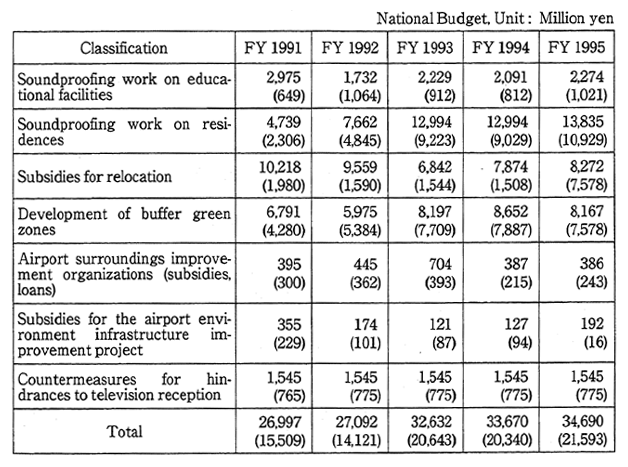
Notes: 1. Figures within parentheses are budget figures related to the Osaka Interna-tional Airport.
2. Excludes survey expenses. etc.
Source: Ministry of Transport
As a result of having promoted vicinity preparation projects, residential sound-proofing projects were mainly completed in 1985,and the indoor environment stipulated by the objective of the environ-mental quality standard concerning aircraft noise has been maintained. Meanwhile,since it is necessary for the airport and the surrounding area to aim for harmonious development while making use of the land that is left after removal,the following policies are being devised.
a. Concerning the Osaka Prefecture surveyed land area in the vi-cinity of the Osaka International Airport,the Ministry of Transport and the Osaka Prefectural government decided to prepare a green area of about 50 hectares. In February 1987,the city plan was decided,in Janu-ary 1988 approval and authorization was received for part of the project, and in September 1994 systematic preparation was carried out for ex-pansion of the project area. Further,in the Hyogo Prefecture surveyed land area also,in March 1993 about 8.6 hectares of green area was de-cided on in a city plan and in September 1993 project approval and authorization was received and systematic preparation is proceeding.
b. At the Hakodate,Sendai,Niigata,Osaka International,Nagoya, Matsuyama,Kochi,Fukuoka and Miyagi Airports,subsidies are being given with respect to the preparation of parks and green paths,etc.,car-ried out by local government bodies that make use of the land left after the removal of residences.
Further,based on the Law for Special Measures Against Air-craft Noise around Designated Airports, at the New Tokyo Interna-tional Airport,in order to plan harmonious land use with the airport,the basic policy for aircraft noise countermeasures was decided by the gov-ernor of Chiba Prefecture in 1983 and based on this the decisions are proceeding on a city plan related to designated areas for the prevention of disturbances arising from aircraft noise.
(D) Countermeasures to Aircraft Noise in the Vicinity of Defense Facilities
Concerning aircraft noise in the vicinity of airports used by the Self-Defense Force,since it is difficult to plan to reduce and lower en-gine noise,considering the original function and objective of self-defense force aircraft,consideration is centering around the use of sound elimi-nation equipment and the regulation of the flight procedures as sound source countermeasures and operations countermeasures. Concerning sound source countermeasures and operations countermeasures for the U.S. forces stationed in Japan in this case,cooperation is being re-quested through a U.S.-Japan Joint Committee.
Up until now,concerning aircraft noise regulation measures in the vicinity of the Atsugi and Yokota Air Bases,agreement has been reached in U.S.-Japan Joint Committees,further,in March 1996 agree-ment was also reached concerning noise regulation measures in the vi-cinities of Kadena and Futenma Air Stations.
As vicinity countermeasures concerning air stations used. by the Japan Self-defense Force,centered on the "Law Concerning the Prepa-ration of the Living Environment in the Vicinity of Self-defense Force Facilities,various countermeasures are being implemented such as aid for the sound-proofing construction work of schools hospitals and resi-dences,compensation for moving buildings,etc.,buying up land,the preparation of green belts and aid with respect to television reception fees (Table 5-1-13).
Further,concerning 26 airport vicinities,as of the end of FY 1995, based on this Law,class one districts have been designated and aid to residential soundproofing construction work is being implemented.
Table 5-1-13 Noise Countermeasure Projects Taken In Areas near Defense Facilites
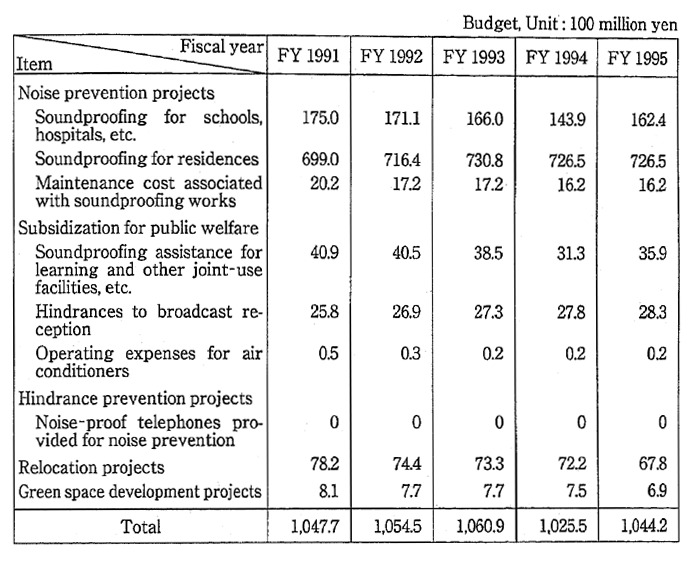
Notes:1. Figures in the table also included some non-aircraft noise countermeasures.
2. Due to rounding in the million yen column,totals in the final column may not match
Source: Defense Agency
E. Shinkansen Train Noise and Vibratiton Countermeasures
The Shinkansen train,since the start of the Tokaido Shinkansen in 1964,has developed as means of mass high speed transportation, but in part of the area along the tracks,noise and vibration have be-come large problems from the standpoint of environmental conserva-tion.
Among these,in the Nagoya region in March 1974,a lawsuit was filed demanding compensation for damage and a ban on the noise and vibration related to the Tokaido Shinkansen.However,in April 1986,an amicable settlement was reached that called for still more promotion generating source countermeasures.
(A) Establishing Environmental Quality Standards and State of Achieving Them
a. Environmental Quality Standards
Environmental Quality Standards Associated with the noise of Shinkansen Trains(29 July 1975) became the objective of Shinkansen train noise countermeasures and,complying with similar types of re-gions,70 decibels or less was s t as what should be achieved or main-tamed for regions mainly used for residences,and 75 decibels or less was set as what should be achieved or maintained for regions used for business and industrial use.
The application to similar regions is carried out by prefectural governors and it is being carried out in all 21 prefectures in which the Shinkansen train operates.
The government,in order to contribute to the harmonious achievement of this environmental quality standard,set Outline of Shinkansen Train Noise Countermeasuresthat stipulated the basic matters of noise source counterimeasures and damege prevention coun-termeasures as a Cabinet understanding in March 1976. ,However,be-fore the partition of the national railroad aud privatization order to ensure the implementation of policies stipulated in this outline and to continue to promote noise countmeasures in the successor corpora-tion that continues the projects of the national railroad and in the japan Railroad Construction Public Corporation,it March 1987Concering the promotion of Shinkansen train noise countermeasures that are railway reorganizationwas agreed upon by Cabinet again.
Further,concerning Shinkansen train vibration,in march 1976 Concerning the Shinkansen train vibration countermeasures that are urgent with respect to environmental conservationwas recommended by the Director-General of the Environment Agency to the Minister of Transport.
b. The State of Achievement of the Environmental Quality Standards
Concerning noise,regarding the Tokaido-Sanyo Shinkansen and the Tohoku-Joetsu Shinkansen,the status was that a considerable num-ber of regions were seen as not having achieved the environmental quality standard,even after the last year of the target time period for achieving the respective environmental quality standards had elapsed. For this reason,the Environment Agency called on the related organi-zations to aim to promote still further countermeasures to make the re-gions of continuous concentrated residential development of the Tokaido-Sanyo Shinkansen and the concentrated residential regions of the Tohoku-Joetsu Shinkansen (hereafter called 75 phons countermea-sure district) 75 decibels or less by the end of FY 1995. In FY 1994,as a result of a survey of the state of achievement,widespread improvement was seen and 75 decibels or less was mostly achieved (Table 5-1-14) and efforts are continuing to be made towards achievement of the environ-mental quality standard. Further,concerning areas other than the rele-vant countermeasure districts as well,demands are being made on the related organizations to devise the necessary countermeasures such as promoting sound source countermeasures in the 75-phons countermea-sure districts newly established in FY 1991.
Table 5-1-14 Noise Situation in Designated 75-phon Countermeasure Dis-tricts (in Fiscal Year 1994)
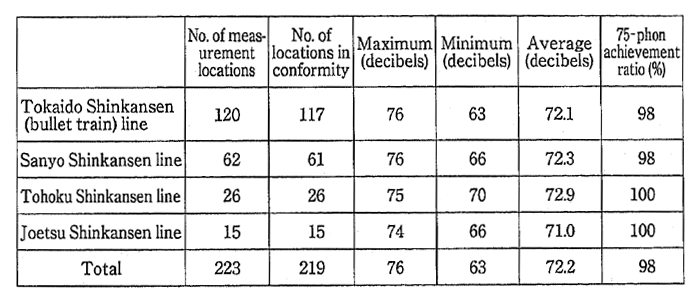
Notes:1. No.of locations in conformity = No.of locations where the noise level was 75 decibels or less.
2. 75-phon achievement ratio (%) = No.of locations in conformity/No.of measure-ment locationsX100
Source:Environment Agency
Concerning vibration,in the Tokaido-Sanyo Shinkansen,after re-vision of the schedule in November 1986,the state of achieving the vi-bration countermeasure guideline value (70 decibels) based on the rec-ommendation of the Director-General of the Environment Agency (March 1976) was surveyed and,except for some points near the tracks, it was achieved at most points,further,on the Tohoku-Joetsu Shinkan-sen,the vibration countermeasure guideline value (70 decibels) was achieved at all points.
(B) Implementation of Countermeasures
The East Japan Railway Company,the Central Japan Railway Company and the West Japan Railway Company received the notifica-tion of the Minister of Transport based on the above mentioned "Out-line of Shinkansen Train Noise Countermeasures" (March 1976 Cabinet understanding) and the recommendation of the Director-General of the Environment Agency (March 1976) and implemented sound source countermeasures,vibration source countermeasures and damage pre-vention countermeasures.
a. Countermeasures for Sound Source and Vibration Source
Concerning the regions where there is a continuous concentra-tion of residences along the Tokaido-Sanyo Shinkansen line,and con-cerning the regions where there are groups of residences along the Tohoku-Joetsu Shinkansen line,comprehensive sound source and vibra-tion source countermeasures that have combined various types of coun-termeasures have been implemented,such as the installation of a new type of sound-proofing wall and ballast mattress construction. However, in FY 1992 and after,what was once the target has since been expanded one more step and,concerning the regions where there are groups of residences along the Tokaido-Sanyo Shinkansen line,and concerning the regions that correspond to the regions where there are groups of residences along the Tohoku-Joetsu Shinkansen line also,various types of noise source and vibration source countermeasures are being imple-mented,such as raising the sound-proofing walls,installing improved sound-proofing walls,deepening the installation of the rail and installing pantograph covers.
b. Countermeasures for Damage Prevention
For some time aid for sound-proofing construction work has been implemented with respect to residences located in districts in which a noise level of 75 decibels is exceeded and with respect to schools and hospitals located in districts in which 70 decibels is exceeded and coun-termeasures are being devised with respect to all target buildings for which applications have been made.
Further,on the Tokaido-Sanyo Shinkansen line,aid for construc-tion work for the prevention of vibration and compensation for moving is being implemented for residences located in districts in which the vi-bration level exceeds 70 decibels,and countermeasures are being de-vised with respect to all target buildings for which applications have been made.
(C) Research and Development of Noise and Vibration Prevention Technology
The research and development of technology that has been sys-tematically promoted by the Japanese National Railways up to FY 1986 for the purpose of implementing sound source countermeasures and vi-bration prevention countermeasures still more effectively,is continuing to be promoted centering on the Railway Comprehensive Technology Research Institute foundation that has succeeded to the work related to the experiments and research of the Japanese National Railways,even after the breakup and privatization of the Japanese National Railways.
In FY 1995 research continued to be carried out on aerodynamic sound countermeasures in order to lower still further the noise of the Shinkansen trains.
F. Noise and Vibration Countermeasures for Conventional Trains
When problems have occurred concerning trains other than the Shinkansen,namely conventional trains,such as complaints and de-mands concerning noise and vibration,the necessary countermeasures have been implemented for each case individually.
In the Environment Agency,because railroad noise and vibra-tion problems occurred along with the opening of the Tsugaru Straits Line and the Seto Ohashi Line,in order to prevent the occurrence of noise problems due to the construction of new lines and in large-scale improvement works (elevation of the track,replacing single tracks with multiple tracks) that rapidly change the environment,study was done on the necessary countermeasures. In December 1995,in addition to stipulating tentative guidelines to become objectives for conserving the living environment and preventing the occurrence of noise problems on the occasion of new construction or large-scale improvements,related organizations have been called upon for cooperation concerning the ap-propriate and harmonious implementation of noise countermeasures in achieving them.
In these guidelines,concerning a new line,60 dB (A) or less in the daytime (7a.m.-1Op.m.) and 55 dB (A) or less at night (10p.m.-7a.m.) are regarded as the equivalent noise levels (L Aeq),and an effort should be made for still further reductions in regions where the residential en-vironment needs to be protected,such as regions for exclusive residen-tial use," was stated,and where there is a line undergoing large-scale improvement "the state of the noise level should be improved to one that is better than it was prior to the improvement"
G. Neighborhood Noise Countermeasures
Recently,the ratio of the complaints concerning the neigh bor-hood noise such as noise generated from late-night business operations from loudspeakers,in homes,etc.,has come to account for 40% of all complaints made,and measures are needed immediately.
In an effort to actively support the residents' activities to prevent noise created in the living environment,which is part of the movement to further improve the pleasant environment (Amenity) in urban areas, various enlightenment activities and a model project that adopted the soundscape method (the Sound Environment Model City Project) were carried out.
Further,based on the spirit of The Basic Environment Plan,in each region,in order to support measures that should conserve a good sound environment by means of the cooperation of local public bodies and residents,thePreserving 100 Soundscapes of Japanproject is be-ing carried out and requests for contributions are being sought through the prefectures.
The Noise Regulation Law specifies that local public entities should take necessary measures to control noise generated by late-night operation of restaurants or bars,noise generated by loudspeakers, and so on. As of the end of FY 1994,restrictions on noise caused by late-night operation were enforced in 39 prefectures and administrative ordinance-designated cities,and restrictions on noise created by loud-speakers were enforced in 41 prefectures,metropolises,and administra-tive ordinance-designated cities.
II. Infrasound Countermeasures
There were approximately 33 cases of complaints concerning in-frasound. Infrasound is vibration caused by air with low frequency that is not audible to human ears,and it vibrates windows,doors,etc. and sometimes affects the human body.
This phenomenon is called infrasound and,according to the stud-ies conducted so far,there is no data that proves any effect given to the human body by the infrasound existing in the general environment.
(2) Offensive Odors Countermeasures
A. The Present State of Offensive Odors
The number of complaints for offensive odors has shown a de-creasing trend for the past 10 years,but in FY 1994 there were 11,946 complaints,an increase of 19.8% compared to the previous year. By in-dustry source,the percentage of complaints involving the livestock in-dustry and various types of manufacturing factories is in a decreasing trend and the percentage of complaints that can be classified as service industry and other so-called urban and daily life types is in an increas-ing trend (Figure 5-1-21).
B. Offensive Odor Prevention Countermeasures
(A) implementation of Regulation Due to theOffensive Odor Control Law
Under the Offensive Odor Control Law,prefectural governors (and mayors of cities designated by the local government law) designate the regulation area and establish the regulation standards,and as of the end of FY 1994,regulation areas have been designated in 1,666 munici-palities (608 cities,913 towns,122 villages,23 wards) equivalent to 512% of all municipalities across the nation.
When it is recognized that levels of foul odors accompanying business activities in designated areas do not attain standards and the foul odors severely affect the surrounding living environment,prefec-tural governors (entrusted to city, town and village mayors) can make recommendation for improvements and issue orders to the operator of the business site to take steps for improvements. In FY 1994, there were six cases where recommendation for improvements were made, and no cases in which orders for improvements were issued. In addition there were 5,375 cases in which administrative guidance was provided to odor-generating business establishments in regulation areas.
Fig. 5-1-21 Trends in Number of Complaints about Offensive Odors
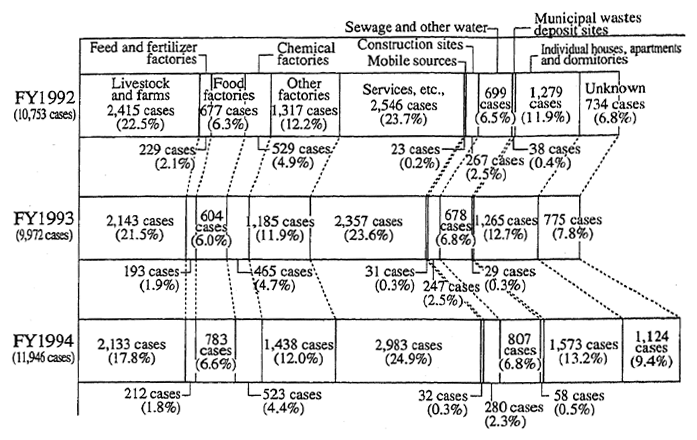
Source: Environment Agency
(B) Enhancement of Offensive Odor Prevention Countermeasures
In the former regulation measures of emission concentrations for each offensive odor substance (22 substances designated by govern-ment ordinance such as ammonia, methylmercaptan), there was the problem of not being able to precisely deal with the offensive odor com-plaints originated in composite odor that can be strongly detected by a person's sense of smell.
Further, in recent years, because the percentage of complaints due to the offensive odors that accompany the daily lives of citizens is trending upwards, appropriate countermeasures to this have come to be necessary.
For this reason, the Offensive Odor Control Law was revised in April 1995. In the districts where complex odors are a problem and countermeasures by means of regulation by emission concentration of offensive odor substances is difficult,instead of this,it was made possi-ble to introduce a regulation standard that used anodor indexcalcu-lated by an offensive odor measurement method through the human sense of smell (olfactory measurement method),and,in addition,the duty of citizens related to the prevention of offensive odors originating in t he daily lives of citizens was established under the law.
Further. in September 1995,due to the preparation of the related Cabinet order. Ordinance of the Prime Minister's Office and the Envi ronment Agency Notification,the establishment of the range of the odor index regulation standard. theOdor Judgment Technicianqualifica-tion system that is a requirement for persons who receive the commis-sion of local government bodies to carry out measurement of the odor index,and the method of calculating the odor index were decided.
(C) Comprehensive Countermeasures for the Conservation of the Olfactory environment
Because there is a trend for the urban and daily life type of odor complaints to increase annually,as measures concerning the conserva-tion of a pleasant olfactory environment,since FY 1995 the participation and cooperation of regional residents has been obtained and the smell environment city model project (clean aroma promotion plan) has been implemented with the objective of arousing a concrete citizens move-ment for the purpose of decreasing the offensive odors accompanying urban life and raising the awareness of the importance of a town's envi-ronmental odor through the creation of an odor map,etc. Further,inves-tigat is is being carried out for the purpose of establishing an olfactory environmental guideline in the air of the general environment
(D) Improvement of Offensive Odor Prevention Technology
A project is being carried out that aims to collect knowledge re-lated to effective offensive odor prevention technology and make it widely known throughout the country so that persons in charge in each local government body can give guidance on appropriate improvement measures to businesses that are the sources of offensive odors,corre-sponding to the type of generating source and the situation of the vicin-ity.
(3) Other Living Environment Countermeasures Concerning the Air
A. In order for citizens to enjoy a fresher and cleaner air environ-ment in their daily lives,it follows that a reduction of air pollutants that directly affect health should be promoted,and as new problems such as heat pollution and heat island come into view,ensuring a clean air envi-ronment from the viewpoint of conservation of the living environment becomes important from now on. For this reason. surveys and investi-gations have started in regards to finding the optimal air environment and the methods to realize it
Further,because the proper awareness and lifestyle changes of each citizen are indispensable in conserving a good air environment,the duty of citizens was prescribed from this kind of viewpoint in April 1995 in the revised Air Pollution Prevention Law and in the Offensive Odor Control Law as well.
B. In order to provide for improving the learning efficiency of chil-dren in all compulsory national education schools in the regions of air pollution,a project to promote the placing of plants in the school envi-ronment was implemented as one on the list of special projects to pro-mote the health of students (FY 1995 budget amount:967,740,000 yen).
Further,assistance has been given for the expenses necessary for pollution prevention construction works at public schools that are in an environment inappropriate for education due to noise pollution. In FY1995 this assistance amounted to 1,093 million yen. The Japanese Pri-vate School Promotion Foundation has a loan program with respect to the pollution prevention construction works of private schools. In FY 1995,the planned lending amount was 500 million yen.
6. Improvement of Air Pollution Monitoring System
Monitoring of the state of air pollution is indispensable for com-prehending the state of achievement of the environmental quality stan-dards and establishing air pollution prevention countermeasures and forms the foundation of air pollution control administration. (Refer to Chapter 9 concerning monitoring on a global scale)
Fig. 5-1-22 NationaI Air Monitoring Network
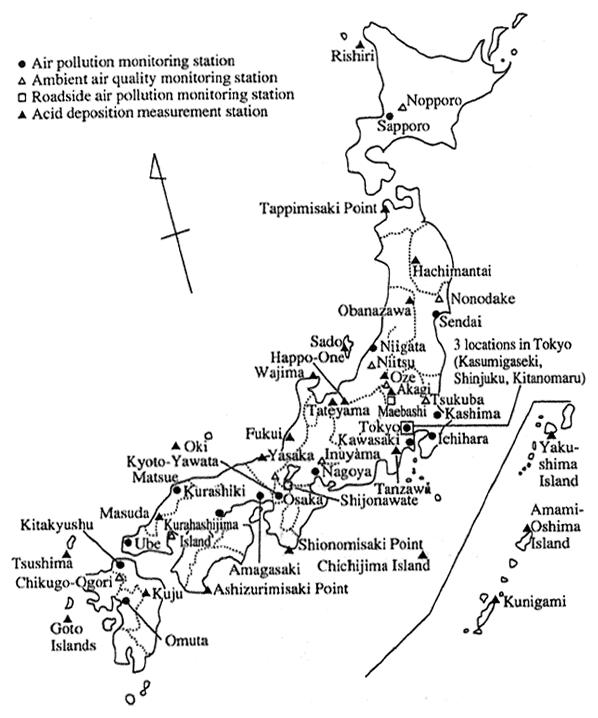
Source;Environment Agency
(1) National Atmospheric Monitoring Network
A. Nationally Atmospheric Monitoring Stations
For the purpose of obtaining the basic data necessary for the pro-motion of air pollution control measures,in addition to comprehending the situation of air pollution from a national perspective,national air pol-lution monitoring stations,national ambient monitoring stations and na-tional roadside air pollution monitoring stations have been established. The distribution of the nationwide national atmospheric monitoring net-work,that is these nationally established atmospheric monitoring sta-tions,in addition to the nationally established acid deposition monitoring stations,are shown in Figure 5-1-22.
National air pollution monitoring stations have been established in 15 locations throughout the country for the purpose of comprehend-ing the state of pollution in important regions. Further,national ambient air monitoring stations have been established in eight locations through-out the country for the purpose of comprehending the state of pollution in regions that are other than the polluted regions in the major plains areas of Japan. The results of measurements in the ambient air monitor-ing stations in FY 1994 are shown in Table 5-1-15. At each monitoring station,various types of measurement equipment were installed and in addition to carrying out measurement of sulfur dioxide,nitrogen oxides and suspended particulate matter,the metallic component of suspended particulate matter and suspended dust was analyzed. Further,at some of the national ambient air monitoring stations,measurement of hydro-gen sulfide and ozone were carried out
For comprehension of the state of pollution alongside roads,na-tional roadside air pollution monitoring stations have been established at three locations in Tokyo,at Maebashi City in Gumma Prefecture and at Shijounawate City in Osaka Prefecture.
Table 5-1-15 Monitoring Results at National Ambient Air Quality Monitorsing Stations (Annual Average Value,Fiscal Year 1994)
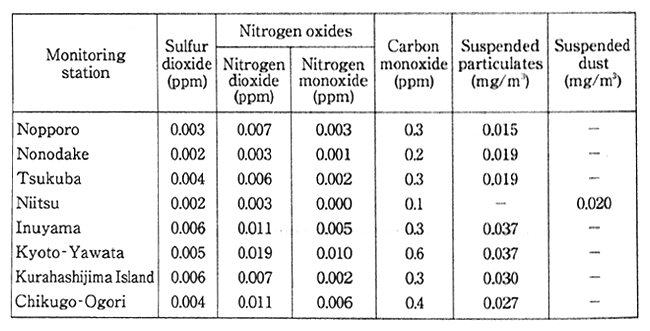
Note:For the locations of the monitoring stations,see Fig.5-1-22.
Source:Environment Agency
B. National Acid Deposition Monitoring Stations
In FY 1987,acid deposition measurement equipment was set up in. 23 national ambient air monitoring stations to comprehend the actual situation of acid deposition in the nation and to elucidate the mechanism of long distance transportation and the influence of acid deposition on the ecosystem. Afterwards,since FY 1988,the establishment of national acid deposition monitoring stations has gradually been carried out. Since FY 1994,the decline of vegetation has been reported and it has been recommended that an acid deposition monitoring station be in-stalled in the mountains in the Kanto region,where acid deposition has been indicated as the cause of this decline. In FY 1995 a monitoring sta-lion was established at Akagi in Gunma Prefecture.
(2) Local Air Pollution Monitoring System
In the local areas,based on the Air Pollution Control Law,in addi-tion to the governments of prefectures and ordinance designated cities which monitor the state of air pollution,other municipal governments also monitor the air pollution condition. The provision of telemetry sys-tems is also being promoted,that carries out monitoring of the concen-tration of sulfur dioxide at sources that emit air pollutants,and the amount of fuel used,and that sends the results of this measurement to a central monitoring center.
Further,in addition to assistance by the national government with respect to providing the measuring equipment necessary for these observations and measurements carried out by the prefectures and government ordinance designated cities,the improvement of a monitor-ing and measurement system to cope with the increasing efficiency and sophistication of measurement technology in a systematic and weighted manner is being aimed for. Modernization of the equipment of the local environmental research institutes has been carried out in order to grasp the actual situation of toxic chemical substances.
Section 2. Conservation of the Water Environment
1. Securing Sound Water Circulation in Environmental Conservation
(1) Achievement and Maintenance of the Environmental Quality Standard Objectives
A. Establishment of the Environmental Quality Standards
The environmental quality standard concerning water pollution specifies,as the objective of the water quality conservation administra-tion,the standard that is desirable to achieve and maintain concerning the water quality at public waters,and is composed of two categories; the environmental quality standards concerning the protection of hu-man health (hereafter called health items); and the environmental quality standards concerning conservation of the living environment (hereafter called living environment items).
Standards values for the former,the health items,are uniformly applied for public waters,while for the latter,the living environment items,types of water areas are differentiated according to the way in which each river,lake,reservoir and coastal area is used,and standards are applied for each. Concerning public waters,the differentiation of types of water areas makes it possible to set forth concrete environ-mental quality standards.
The health items were greatly revised in March 1993. At present, a total of 23 items have been established,including heavy metals like cadmium and lead;organochlorine compounds such as trichloroethyl-ene;and agricultural chemicals such as simazine. In addition,guideline values have been established concerning items that require monitoring, and efforts are being made to compile more water quality data in an ef-fort to prevent water pollution.
Concerning the living environment items,BOD (biochemical oxy-gen demand),COD (chemical oxygen demand) and DO (dissolved oxy-gen) standards have been established. Moreover,in order to prevent eu-trophication,environmental quality standards were applied in August 1993 concerning total nitrogen and total phosphorus levels,and also newly covering coastal areas in addition to the lakes and reservoirs for which standards had been previously established.
Furthermore,because environmental quality standards concern-ing the living environment is designated to water areas based on the water usage,a review of the designation of water area type is under-way concerning water areas for which a change of water utilization has been recognized.
Moreover,regarding the removal of bottom sediment containing organic substances,provisional removal standards have been estab-lished,respectively,for bottom sediment containing mercury and PCBs.
B. The Present State of Water Pollution
(A) Public Water Areas
According to the FY1994 results of surveys of the water quality of national public waters,along with the March 1993 revision of the En-vironmental quality standards,evaluation is also being carried out based on the new environmental quality standards from 1993 concern-ing the environmental quality standards regarding protection of human health. Of 5,516 measurement sites nationwide,47 sites exceeded the en-vironmental quality standards,signifying a 0.85% non-achievement rate (Table 5-2-1).
In addition,the proportion of analyzed water samples in non-compliance with the environmental quality standards (percentage of non-compliance) in FY 1994 mark d an increase over the previous year from 0.58% to 0.85%. This is considered to b due to the increased num-ber of sites that exceeded t he environmental quality standards of arse-nic for natural causes. [Refer to Figure 5-2-1.]
On the other hand,regarding items related to the conservation of the living environment,such as BOD and COD,concerning the 3,156 water areas to which environmental quality standards had been applied up to FY 1993 (2,447 rivers,128 lakes and reservoirs and 581 ocean ar-eas),68.9% (compared to 76.5% in FY 1993) of all the water areas achieved the BOD (or COD) environmental quality standards that is the typical water quality index of organic pollution,signifying a 31.1% non-achievement rate of the environmental quality standards. This was mainly due to a decline in the achievement percentage of rivers,and is considered to have stemmed from a decrease in river flow due to a water shortage.
Also,when this is examined categorically by water area,the achievement rates are 67.9% for rivers (compared to 77.3% in FY 1993), 40.6% for lakes and reservoirs (compared to 46.1% in FY 1993) and 79.2% for coastal areas (compared to 79.5% in FY 1993). The percentage of compliance with environmental quality standards was low,a before, particularly in enclosed water areas such as lakes and reservoirs,inner bays and the Inland Sea,and in small-and medium-sized river in cities (Fig. 5-2-2,Fig. 5-2-3,Fig. 5-2-4,Fig. 5-2-5,Table 5-2-2).
Table 5-2-1 Ratio of Monitoring Points Exceeding the Environmental Quality Standards for Health Items
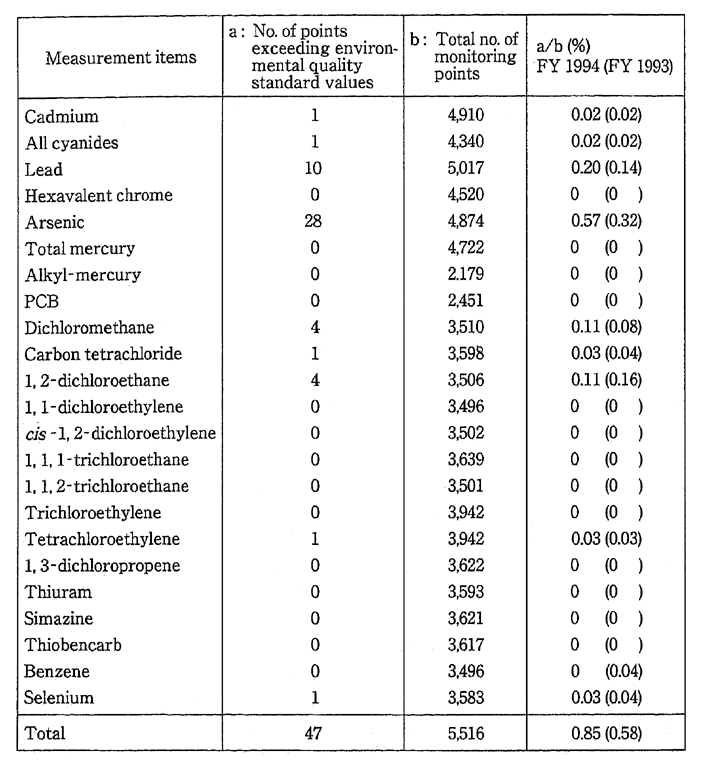
Other modes of water pollution include groundwater pollution by trichloroethylene,etc.,wide-area pollution centering on river mouths and inner bay areas by organic tin compounds,pollution of public water areas by toxic substances from accidents,and oil spills in some water ar-eas. There are also influences on the environment by the long-term pol-lution that accompainies dam construction,the acidification of rivers or lakes and reservoirs in volcanic zones due to natural causes and the dis-charge of warm water by large-scale electric power generation plants.
Fig. 5-2-1 Trend in Non-conformity Ratios by Health Item (Evaluations under old Environmental Quality Standards) (As for alkyl mercury,the non-conformity ratio has been 0% since fiscal year 1971,)
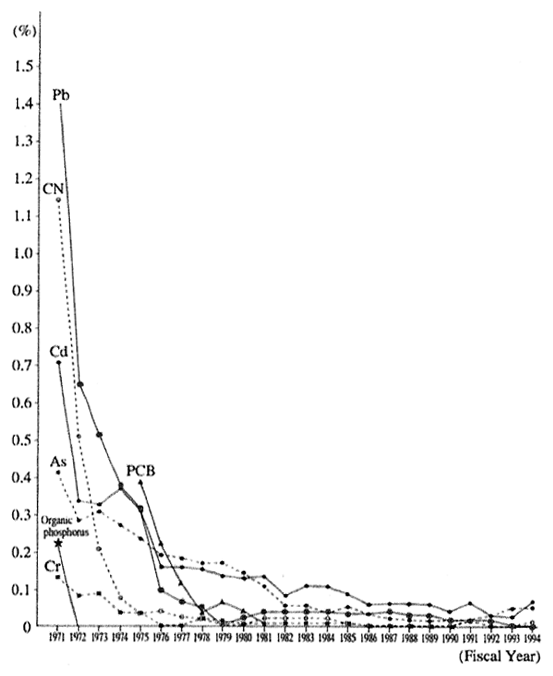
Fig.5-2-2 Trend in Conformity to Environmental Quality Standards (BOD or COD) (By Type of Water Category)
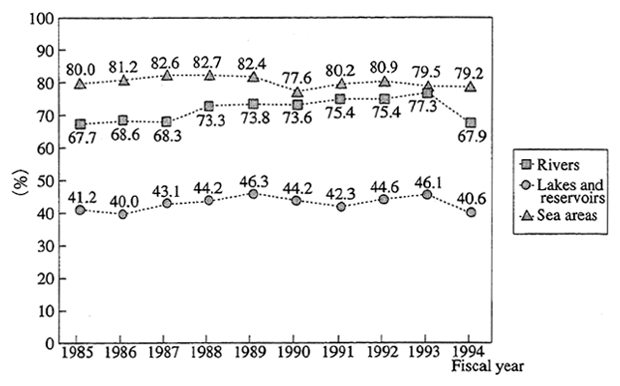
Fig.5-2-3 Trend in Conformity to Environmental Quality Standards (COD) in Three Major Sea Areas
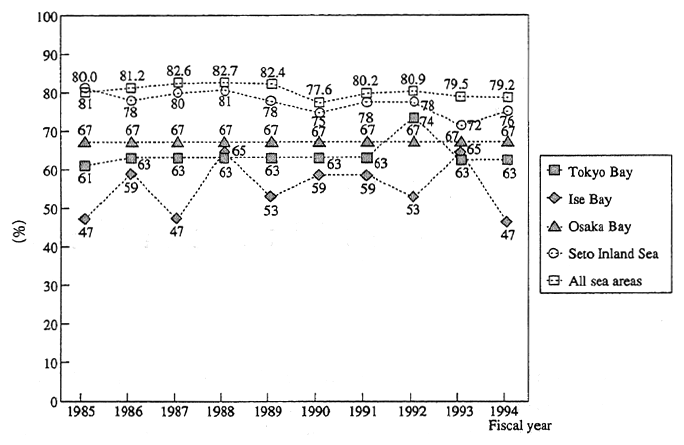
Fig.5-2-4 State of Water Pollution in Major Rivers (Fiscal Year 1994)
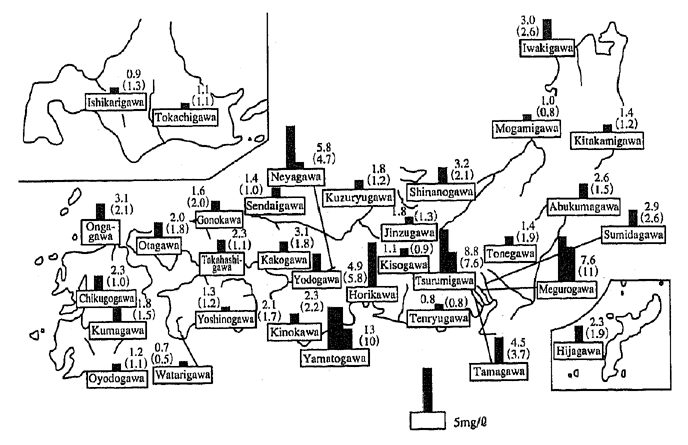
Note:1. BOD annual average value. Unit:mg/liter
2. Figures within parentheses are from th fiscal year 1993 survey.
Souce:Environment Agency
Fig.5-2-5 State of Water Pollutioin in Major Lakes, Reservoirs and Inner Bays (Fiscal Year 1994)
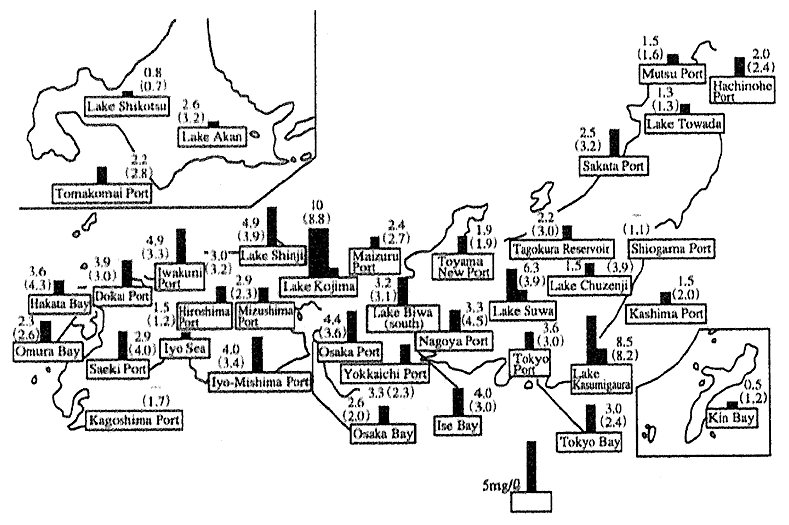
Note:1. COD annual average value. Unit:mg/liter
2. Figures within parenheses are from the fiscal year 1993 survey.
Source:Environment Agency
Table 5-2-2 State of Conformity to Environmental Quality Standards (BOD or COD)
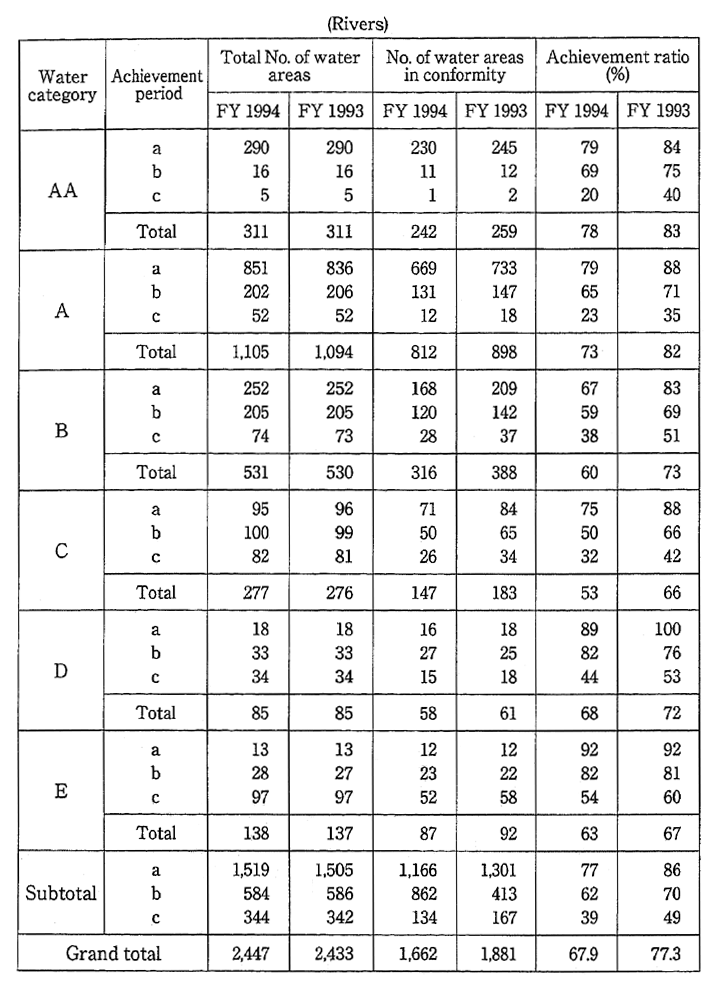
Table 5-2-2 State of Conformity to Environmental Quality Standards (BOD or COD)(contd)
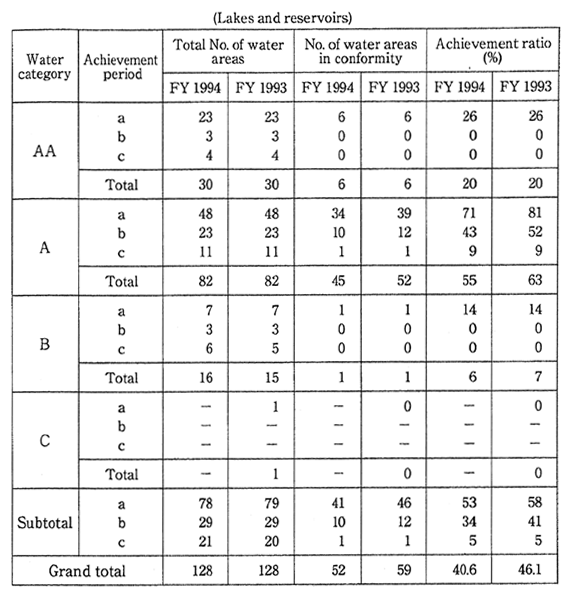
(B) Groundwater
Groundwater pollution by trichloroethylene,etc. has spread throughout Japan and has been generally recognized. Therefore,the state of groundwater pollution has been consistently monitored since FY 1988 based on the Water Pollution Control Law. Measurement of groundwater quality has come to be carried out by the national and lo-cal public entities in accordance with the groundwater quality measure-ment plans of each prefecture.
Table 5-2-2 State of Conformity to Environmental Quality Standards (BOD or COD)(contd)
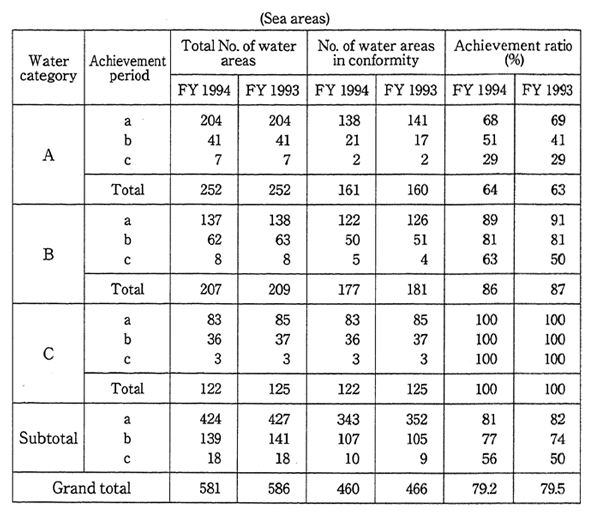
Note: Figures of the FY 1994 survey and the FY 1993 survey are the results of the measurements conducted in those water areas where water categories were ap-plied by FY 1993 and FY 1992,respectively.
According to the FY 1994 results of the measurement of ground-water quality,a Survey of the General Condition (a survey conducted in order to gain an overview of the overall state of each region's ground-water quality) was implemented in 1,498 cities,towns and villages. The percentage of wells that exceeded the evaluation standards (percentage of sites exceeding standards) was 0.1% (2 out of 2,523) for lead,3.1% (91 out of 2,914) for arsenic,01% (2 out of 2,808) for carbon tetrachloride, 0.04% (1 out of 2,643) for 1,2 dichloroethane,0.2% (5 out of 2,671) for 1,1 di-chloroethylene,0.3% (9 out of 2,670) for cis-1,2 dichloroethylene,0.03% (1 out of 3,868) for 1,1,1-trichloroethane,0.3% (11 out of 3,996) for trichlo-roethylene and 0.7% (29 out of 3,998) for tetrachloroethylene (Table 5-2-3).
Table 5-2-3 Groundwater Quality Monitoring Results for Fiscal Year 1994 (General Condition Survey)
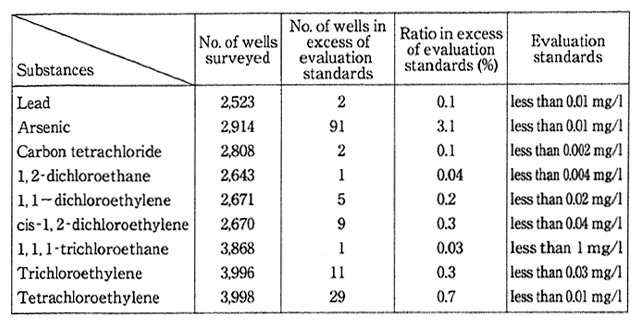
Note:1.The evaluation standards are identical to the standard values of health items in the water environmental quality standards. Revisions to the water environ-mental quality standards in March 1993 eliminated organic phosphorus from the list and added 13 substances,including 1,1,1-trichloroethane.(For trichlo-roethylene and tetrachloroethylene,the evaluation standards have already been set). In addition,the evaluation standards for lead and arsenic were strengthened.
2. Evaluation standards were not exceeded for all items not listed above.
Furthermore,in a Survey of Districts near Polluted Wells (a sur-vey with the objective of checking the range of the pollution newly dis-covered by the Survey of the General Condition),there was a percent-age of sites exceeding standards of 30.6% (211 out of 689) for arsenic, 0.2% (1 out of 580) for carbon tetrachloride,1.7% (5 out of 299) for 1,1-dichloroethylene,3.8% (17 out of 444) for cis-1,2-dichloroethylene,0.1% (2 out of 1,440) for 1,1,1-trichloroethane,2.0% (32 out of 1,574) for trichlo-roethylene,16.7% (274 out of 1,643) for tetrachloroethylene and 0.8% (1 out of 124) for benzene.
In a Routine Monitoring Survey (a survey for the purpose of con-tinuously monitoring pollution that had been confirmed by the Survey of Districts near Polluted Wells),there was a percentage of sites exceed-ing standards of 0.9% (6 out of 700) for lead,1.1%(8 out of 717) for hexavalent chrome,14.2% (130 out of 913) for arsenic,2.3%(17 out of 726) for total mercury,1.6% (26 out of 1,594) for carbon tetrachloride,1,1%(13 out of 1,219) for 1,1-dichloroethylene,6.6% (81 out of 1232) for cis-1,2-dichloroethylene,0.2%(7 out of 3,663) for 1,1,1-trichloroethane,8.3%(321 out of 3,887) for trichloroethylene and 18.3%(713 out of 3,903) for tetra-chloroethylene.
Moreover,no wells exceeded the evaluation standards for other substances in any of the surveys.